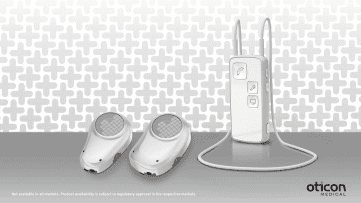By Brian Taylor, AuD
During the pandemic, many people experienced a decrease in hearing loss symptoms due to the lack of crowded, noisy gatherings they were exposed to. As most of us were isolated in our homes for extended periods, the only talking we did was with our inner circles, which helped mask certain kinds of hearing struggles.
Research conducted by the University of Michigan and Apple revealed that the pandemic’s stay-at-home orders cut people’s exposure to noise by about half. With no chatting across the table in noisy restaurants, no business meetings in conference rooms or hotel ballrooms, and no crowded social events, there were far fewer perceptible signs of hearing loss.
This reduced exposure to noise benefited those with hearing loss, who often have difficulty hearing in the presence of noise. However, now that we are reemerging from pandemic-style lifestyles, the volume has returned to normal, and hearing care professionals (HCPs) can expect to see more patients with hearing difficulties in noisy situations as the public grows more aware of the issue—and as unaddressed hearing loss becomes intolerable.
Further reading: How to Employ Research and Phone Apps to Avoid Unsafe Noise Levels
Confronting the Impact of Unaddressed Hearing Loss
One of the challenges posed by unaddressed hearing loss is that not enough people take care of their hearing or seek hearing aids when they require them. Hearing loss can sneak up on people beginning at a young age–the World Health Organization estimates that over a billion people aged 12 to 35 worldwide are at risk of hearing loss due to exposure to loud sounds and music.
While mild-to-moderate hearing loss may seem tolerable, it can manifest itself in ways that impact people’s ability to understand or communicate. This type of hearing loss can cause sufferers to miss conversations or withdraw from noisy situations, leading to isolation that can affect their mental and physical health.
New Hearing Technology Tackles the Problem
Hearing technology has advanced significantly in its ability to improve hearing in noisy situations. Today’s hearing aids, bolstered with tools like directional microphones and advanced signal processing, can distinguish unwanted ambient noise from speech. They can also tell where the noise is coming from and diminish its impact while enhancing desired sound.
At Signia, for example, engineers have developed Own Voice Processing (OVP), now in its second version, which learns to recognize when the wearer is speaking, especially in noisy situations, and processes the speaker’s voice to sound more natural while separating it from all of the background noise. This is done using unique Augmented Focus split-processing technology that processes speech and background noise separately to create a clear contrast between the two.
This function allows wearers to hear people talking to them at parties and feel confident in social situations. OVP 2.0 even supports a new My WellBeing smartphone app that helps people understand how engagement in regular conversation leads to a healthier life.
Enhancing Care to Address Patient Needs
While advanced processing technologies like OVP and split processing are innovative and becoming essential to increased quality of life for hearing aid wearers, for many the technology is secondary to the results they can feel tangibly. For people who struggle in everyday social scenarios—hearing what their partner is saying in a noisy restaurant, for example—intelligibility and clarity are their top priorities regardless of what kind of hearing aid they (hopefully) eventually adopt.
A recent study found that across all technology levels, hearing aid wearers’ top preferences were intelligibility and comfort, even above ease of use, connectivity, and other common features.
Comfort ensures that patients wear their hearing aids as often as needed, and intelligibility addresses the growing challenge of being able to hear in noisy situations and the related risks of social withdrawal. That said, the technology required to achieve clear hearing and help hearing loss sufferers thrive in noise should be more widely accessible. After all, prioritizing hearing care benefits patients’ wellness and quality of life.
Signia has taken that challenge seriously and has recently made its most advanced Augmented Xperience (AX) processing platform available across more price points and performance levels to accommodate as many patients as possible. Signia is also committed to continuous improvement in order to maintain the highest quality services for HCPs and patients. The AX platform is regularly updated, with six new enhancements added since its initial release.
As we navigate our noisy world, modern hearing technology is leveling up to provide the best care and most support for patients to help them tune in and reconnect.
Brian Taylor, AuD, is senior director of audiology at Signia, a division of WS Audiology. For more information, contact [email protected].






